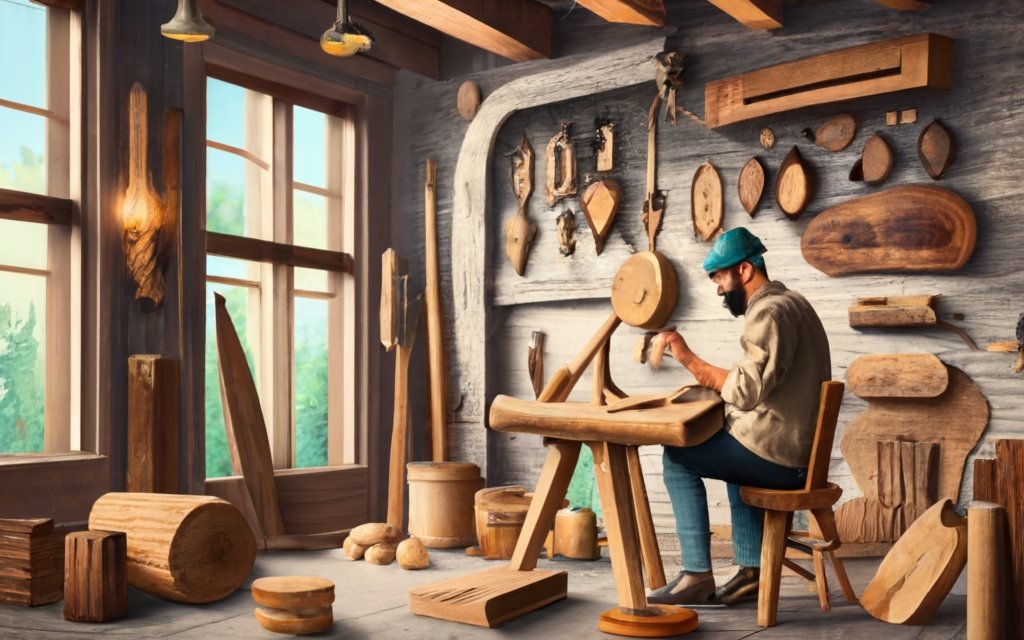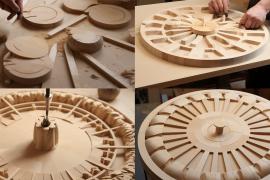Introduction
Creating beautiful wooden-themed decor begins long before the artisan’s tools shape the raw wood. Each piece’s origins, processing, crafting, and inspection impact its quality. The choice of wood species, sustainability, and sourcing practices are pivotal factors influencing the decor’s aesthetics and environmental impact. Additionally, the artisan’s skill and attention to detail during crafting are crucial in ensuring the final product’s elegance and durability. Lastly, thorough inspection and quality control procedures guarantee that every piece meets the highest standards of craftsmanship.
The Harvesting of Raw Timber
The journey starts by identifying and harvesting appropriate tree species from responsibly managed forests. Trees’ age, size, straightness, and health determine their suitability. Harvest techniques like selective cutting prevent over-logging and allow forests to regrow. This sustainable approach ensures a continuous supply of raw timber for various industries while safeguarding the delicate balance of forest ecosystems. Forest certification programs, such as FSC (Forest Stewardship Council), help consumers identify products sourced from well-managed forests, promoting responsible timber harvesting practices.
The Milling Process
Logs are transported to sawmills, cut lengthwise, graded, and kiln-dried to optimum moisture levels for carpentry work. Precise milling maximizes usable lumber while minimizing irregular grain or knotting.
Drying and Storing the Wood
Kiln drying reduces moisture to 8-10% under controlled conditions to prevent cracking as wood releases moisture. Dried planks are sorted by grade, length, and attributes. Proper storage protects lumber from warping before furniture makers begin crafting.
Designing the Wooden-decor
Artisans sketch plans matching the lumber characteristics to each decor piece’s structural and aesthetic goals. The grain patterns, colour variations, and natural defects in the wood influence the form and joinery techniques used.
Crafting the Wooden-decor
Using the finalized designs, craftspeople shape the lumber into decor items like shelves, signs, mirrors, clocks, and wall art, incorporating the desired themes and personalization elements.
The Art of Crafting Wooden-Themed Decor
Skilled artisans use time-honed techniques to transform milled lumber into personalized, creative wooden decor.
The Importance of Craftsmanship
The mastery of an artisan’s craft is exemplified by their ability to breathe life into each piece, transforming it into an enduring work of art. This expertise ensures that every curve and contour is precisely sculpted, elevating the decor to timeless elegance. This unwavering commitment to perfection distinguishes heirloom-quality craftsmanship from mere decorative embellishments.
The Tools of the Trade
While hand tools like mallets and chisels remain essential, artisans also utilize power tools like lathes, Sanders, and routers for efficiency. The combination achieves hand-worked charm alongside modern reliability.
Techniques for Crafting Wooden-Themed Decor
Techniques like rounding, tapering, carving, wood burning, intarsia, marquetry, and whittling shape the wood while creating decorative effects. Joinery-like dovetails cleanly and sturdily connect pieces.
The Role of Sanding and Finishing
Sanding smoothens the decor surfaces while minimizing imperfections before the finish is applied. The finishing process seals and protects the wood, enhancing its grain patterns and colouration.
Quality Control and Inspection
At each production step, artisans verify dimensions, joinery strength, theme execution, personalization accuracy, and safety. Only pieces meeting stringent quality standards get final approval.
The Types of Wooden-Themed Decor
Wooden decor spans styles from rustic to modern, using personalized themes tailored to home aesthetics.
Rustic Wooden Decor
Rustic decor incorporates imperfections like knots, cracks, stain variations, and rough edges to convey natural and weathered charm. Favourite themes include animals, trees, and cabin life.
Modern Wooden Decor
Sleek, minimalist decor with clean lines, abstract shapes, and solid colours fit modern aesthetics. Geometric patterns and inspirational quotes are popular themes.
Industrial Wooden Decor
Industrial styles feature exposed joinery, metal accents, and unfinished surfaces for urban-chic decor. Gears, pipes, and urban skylines are fitting themes.
Traditional Wooden Decor
Elegant traditional decor utilizes ornate curves, delicate florals, and posh finishes. Monograms, family crests, and floral wreaths make cherished themes.
Contemporary Wooden Decor
The contemporary decor combines old and new, blending natural wood grains with bold colours, patterns, and unconventional shapes inspired by current trends.
The Benefits of Wooden-Themed Decor
Beyond their customizable artistic appeal, wood furnishing and decor provide many lifestyle benefits.
Durability and Longevity
Unlike fast furniture, solid wood construction withstands everyday wear. With care, heirloom-quality wooden decor ages gracefully, lasting generations.
Sustainability and Eco-Friendliness
Ethically sourced natural timber is renewable and biodegradable. Choosing wood promotes environmental sustainability and responsible forestry.
Versatility and Adaptability
Wood’s workability allows artisans to craft decor tailored to the client’s space. Wooden decor complements any aesthetic from modern to farmhouse.
Aesthetic Appeal and Warmth
Wood’s natural beauty, resonance, and warm hues create welcoming atmospheres. Carvings, finishes, and grains add unique character.
Health Benefits and Well-Being
Being surrounded by natural wood environments lowers stress, heart rates, and fatigue while boosting moods.
The Comparison of Different Types of Wood
Understanding wood characteristics helps match specific boards for decor purposes.
Hardwood vs. Softwood
Hardwoods like oak and walnut are denser, stronger, and more expensive. Softwoods like pine are more accessible and affordable.
Oak vs. Pine
Oak has attractive grains but requires careful sealing. Easy to work pine needs frequent repairs over time.
Mahogany vs. Cherry
Prized reddish mahogany wears well with careful handling. Delicate cherry darkens beautifully yet scratches easily.
Maple vs. Walnut
Maple takes stain consistently with tight, straight grain. Walnut imparts more decadent warmth with swirling grain patterns.
Cedar vs. Redwood
Aromatic rot-resistant cedar suits outdoor use despite knots. Stable redwood with tighter grains also withstands weathering.
| Aspect | Raw Timber | Wooden Themed Decor |
| Source | Harvested trees | Finished products |
| Initial Form | Logs and planks | Furniture, accents, and decor items |
| Processing | Sawing, drying, milling, and shaping | Designing, carving, staining, and finishing |
| Sustainability | Environmental impact due to deforestation | Sustainable sourcing, recycling, and upcycling efforts |
| Craftsmanship | Minimal initial craftsmanship required | High-level craftsmanship and attention to detail |
| Durability | Susceptible to decay and pests | Enhanced durability through treatments and finishes |
| Customization | Limited customization in raw timber form | Highly customizable in design and aesthetics |
| Style and Aesthetics | Limited aesthetic appeal in raw form | Offers a wide range of styles and finishes for decor |
| Environmental Impact | High carbon footprint initially | Can be eco-friendly with sustainable practices |
| Cost | Lower initial cost for raw timber | Higher cost due to craftsmanship and customization |
| Maintenance | High maintenance for raw timber structures | Moderate maintenance for decor items |
| Versatility | Limited use as raw timber | Versatile for various decor applications |
| Market Availability | Widely available in its raw form | Available as a niche market for decor enthusiasts |
| Longevity | Relatively shorter lifespan in raw form | Longer lifespan as finished decor with proper care |
| Unique Selling Points | Natural and rustic appeal in its raw state | Unique, handcrafted pieces for interior decor |
Conclusion
Personalized wooden decor allows for imbuing spaces with heartfelt artistic flair reflective of owners’ styles, interests, and values. Yet behind even modest plywood home accents lies an intricately orchestrated journey from tree harvesting to milling, carpentry, finishing, and inspection by generations of skilled craftspeople. Their collective mastery of wood as a creative medium transforms a living tree into a themed bookshelf, sign, or toy chest infused with imagination, purpose, and labour. For wooden decor lovers, these handcrafted furnishings beautify spaces and quietly convey humanity’s wondrous ingenuity and the natural world’s gifts.



